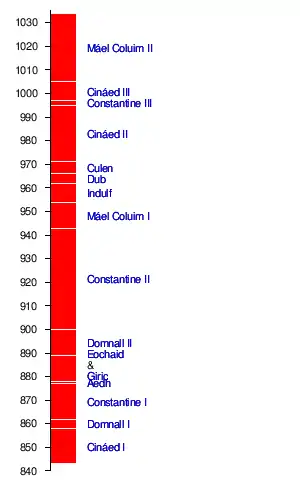House of Alpin
The House of Alpin, also known as the Alpínid dynasty, Clann Chináeda, and Clann Chinaeda meic Ailpín, was the kin-group which ruled in Pictland, possibly Dál Riata, and then the kingdom of Alba from the advent of Kenneth MacAlpin (Cináed mac Ailpín) in the 840s until the death of Malcolm II (Máel Coluim mac Cináeda) in 1034.
| House of Alpin | |
|---|---|
| Country | Kingdom of the Picts? Kingdom of Dál Riata? |
| Founded | Before 763 |
| Founder | Alpín mac Echdach |
| Final ruler | Malcolm II of Scotland |
| Titles | High King of Alba[1][2] King of the Picts King of Picts and Scots King of Alba King of Dál Riata (possibly) |
| Dissolution | 1034 |

Kings traced their descent from Kenneth MacAlpin (and not from his father, Alpín mac Echdach), and Irish genealogies in the Book of Ballymote and the Book of Lecan refer to the kindred as Clann Cináeda meic Ailpín by prioritising descent from Kenneth.[3]
The origins of the family are uncertain. Later genealogies make Kenneth a descendant of Áed Find. While plausible, such claims are unprovable and appear only in the late tenth century.[4] The associated idea that Kenneth had been a king in Dál Riata before he contended successfully for power in Pictland in the 840s, following the death of Eóganán mac Óengusa, is supported by nearly contemporary evidence.[5]
Early kings of Clann Cináeda meic Ailpín are described as kings of the Picts, and the third king, Kenneth's son Constantine I (Causantín mac Cináeda), appears to have been regarded as the last of the 70 Pictish kings soon after his death. The descendants of Kenneth were ousted in 878, when Constantine I's brother, Áed mac Cináeda, was killed by Giric mac Dúngail, but they returned in 889, when Constantine I's son Donald II (Domnall mac Causantín) ascended the throne upon the death or deposition of Giric. Donald II and his successors are described as kings of Alba.[6]
During the tenth century, succession alternated between the descendants of Constantine I and those of Áed. Internecine strife in the late tenth and early eleventh centuries left the descendants of Constantine I unchallenged by male-line descendants of Kenneth MacAlpin, but Malcolm II left no male heirs. On Malcolm's death, the line of kings descended from Kenneth came to an end. Future kings, while still tracing their descent from Kenneth, were descended from Malcolm's daughter Bethóc and her husband Crinan of Dunkeld.[7]
Notes
- Downham, Claire. "Scottish Affairs and the Political Context of Cogadh Gaedhel Gallaibh" (PDF). p. 6.
- "Cogadh Gaedhel re Gallaibh, Chapter XXV(25) (left side of the page)". p. 232.
- Woolf, Pictland to Alba, pp. 222–224; Broun, Irish Identity, pp. 173–174.
- Woolf, Pictland to Alba, p. 173.
- Woolf, Pictland to Alba, pp. 93–98 & 116–117.
- Woolf, Pictland to Alba, pp. 122–126.
- Woolf, Pictland to Alba, pp. 225–230.
References
- Anderson, Alan Orr (1922), Early Sources of Scottish History A.D. 500 to 1286, vol. I (1990 revised & corrected ed.), Stamford: Paul Watkins, ISBN 1-871615-03-8
- Bannerman, John (1999), "The Scottish Takeover of Pictland and the relics of Columba", in Broun, Dauvit; Clancy, Thomas Owen (eds.), Spes Scotorum: Hope of Scots. Saint Columba, Iona and Scotland, Edinburgh: T. & T. Clark, pp. 71–94, ISBN 0-567-08682-8
- Broun, Dauvit (1999), "Dunkeld and the origins of Scottish Identity", in Broun, Dauvit; Clancy, Thomas Owen (eds.), Spes Scotorum: Hope of Scots. Saint Columba, Iona and Scotland, Edinburgh: T. & T. Clark, pp. 96–111, ISBN 0-567-08682-8
- Broun, Dauvit (1999), The Irish Identity of the Kingdom of the Scots in the Twelfth and Thirteenth Centuries, Woodbridge: Boydell Press, ISBN 0-85115-375-5
- Broun, Dauvit; Clancy, Thomas Owen (1999), Spes Scotorum: Hope of Scots. Saint Columba, Iona and Scotland, Edinburgh: T. & T. Clark, ISBN 0-567-08682-8
- Duncan, A. A. M. (2002), The Kingship of the Scots 842–1292: Succession and Independence, Edinburgh: Edinburgh University Press, ISBN 0-7486-1626-8
- Herbert, Máire (2000), "Ri Éirenn, Ri Alban: kingship and identity in the ninth and tenth centuries", in Taylor, Simon (ed.), Kings, clerics and chronicles in Scotland 500–1297, Dublin: Four Courts Press, pp. 62–72, ISBN 1-85182-516-9
- Smyth, Alfred P. (1989) [1984], Warlords and Holy Men: Scotland AD 80–1000, Edinburgh: Edinburgh University Press, ISBN 0-7486-0100-7
- Taylor, Simon, ed. (2000), Kings, clerics and chronicles in Scotland 500–1297, Dublin: Four Courts Press, ISBN 1-85182-516-9
- Woolf, Alex (2007), From Pictland to Alba, 789–1070, The New Edinburgh History of Scotland, Edinburgh: Edinburgh University Press, ISBN 978-0-7486-1234-5